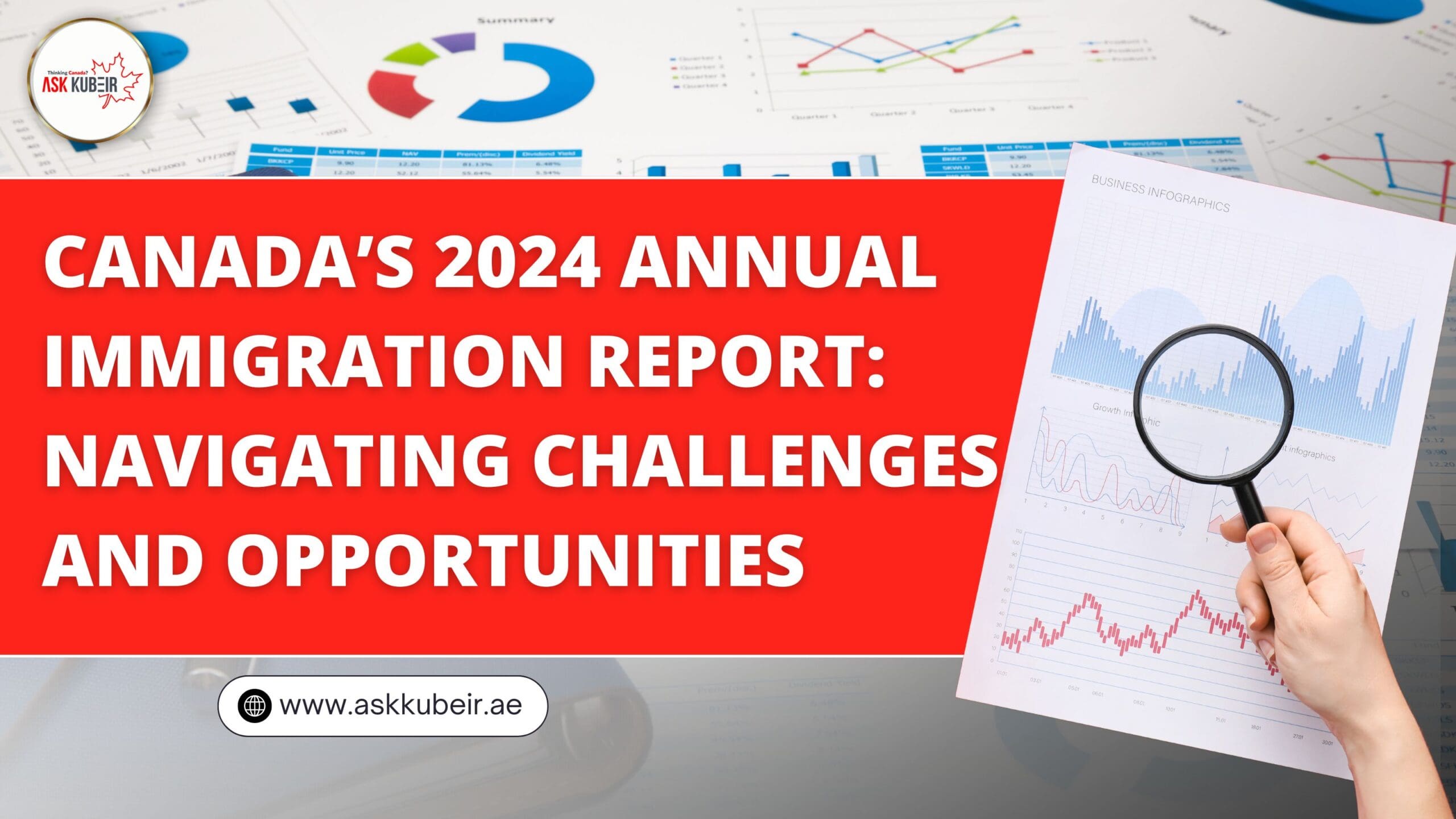
Introduction
The 2024 Annual Immigration Report to Parliament offers a comprehensive look at Canada’s immigration journey over the past year. Mandated by the Immigration and Refugee Protection Act (IRPA), this report provides Parliament and Canadians with detailed insights into immigration policy progress, admission statistics, and strategic initiatives. It underscores immigration’s role in sustaining Canada’s economic growth, supporting demographic needs, and fostering inclusivity.
In addition to permanent resident admissions and temporary resident volumes, this report discusses collaborative efforts between federal and provincial governments, the promotion of Francophone immigration, and diversity considerations to ensure an equitable and effective immigration framework. This article provides an in-depth analysis of Canada’s immigration achievements, challenges, and plans for the coming year.
The Role of Immigration in Canada’s Economic and Social Fabric
Immigration remains integral to Canada’s cultural, social, and economic landscape. Not only does it contribute to the post-pandemic recovery, but it also mitigates demographic challenges posed by an aging population. With nearly one-quarter of the Canadian population comprised of first-generation immigrants, Canada relies on immigration to attract new workers, sustain economic growth, and support family reunification and humanitarian efforts.
Economic Contributions of Immigrants
In 2023, Canada welcomed 471,808 immigrants, with 58% arriving through economic streams. Immigrants support the Canadian economy by participating in various sectors, including healthcare, technology, and professional services. Notably:
- Immigrants contribute significantly to Canada’s labor force: They represented 28.9% of the Canadian workforce in 2023, providing essential skills that drive innovation and economic productivity.
- Immigrant entrepreneurship: Canada is home to over 800,000 immigrant entrepreneurs, whose businesses stimulate job creation and foster innovation. Canada’s Start-up Visa program attracts global founders by offering permanent residency, enhancing Canada’s reputation as a top destination for entrepreneurs within the OECD.
These economic contributions demonstrate the indispensable role of immigrants in enhancing Canada’s economic capacity.
Addressing Challenges in Immigration
While immigration is key to Canada’s growth, it also presents challenges, particularly in housing, credential recognition, and access to social services. Managing these issues effectively requires a coordinated approach across government levels and community organizations.
Housing Pressures
Canada is grappling with a significant housing shortage exacerbated by population growth. As the population expands, particularly in urban centers such as Toronto, Vancouver, and Montréal, housing demand outpaces supply. Vacancy rates have declined to a historic low of 1.5%, placing pressure on housing availability and affordability.
To address this, Canada has implemented several initiatives:
- Federal Housing Assistance: In 2023, the federal government allocated $1 billion to the Interim Housing Assistance Program (IHAP) for interim housing solutions.
- Incentivizing Housing Construction: Measures announced in the 2023 Fall Economic Statement aim to encourage new rental housing construction, ensuring a sustainable response to increasing housing demands.
Labor Market Integration and Credential Recognition
Another major challenge for newcomers is credential recognition, which limits employment opportunities in specialized fields. Canada is working on streamlining processes for internationally trained professionals, particularly in sectors facing labor shortages, such as healthcare and skilled trades.
Efforts include:
- Category-based Selection in Express Entry: In 2023, Express Entry introduced a new category for trades, aiming to meet anticipated shortages of approximately 22,700 workers until 2031.
- Collaboration with Provinces: By partnering with provinces, Canada can better align immigration streams with local labor needs, addressing regional shortages while fostering economic integration for immigrants.
Supporting Indigenous Communities
Immigration, Refugees and Citizenship Canada (IRCC) is working to address unique challenges faced by First Nations, Inuit, and Métis communities in cross-border migration. In collaboration with the Canada Border Services Agency, IRCC is exploring legislative amendments to facilitate border-crossing access for Indigenous peoples separated by Canada’s borders.
Indigenous-Targeted Initiatives
IRCC has implemented an Action Plan under the United Nations Declaration Act, focusing on legislative reforms and policy adjustments that respect Indigenous rights and address their distinct needs in migration and border access.
Immigration’s Role in Addressing Demographic Challenges
Canada’s aging population poses significant challenges. The worker-to-retiree ratio is expected to decrease, necessitating a stable influx of working-age immigrants. With fertility rates below replacement levels, immigration has become essential for sustaining population growth and supporting economic stability.
Population Growth and Workforce Sustainability
- Net International Migration: Between 2022 and 2023, net migration accounted for nearly 98% of Canada’s population growth, with immigration serving as the primary factor in countering low birth rates.
- Economic Necessity: Projections indicate that by 2030, five million Canadians will retire, intensifying the need for younger immigrants to support the workforce and maintain economic productivity.
Francophone Immigration and Regional Distribution
To support Canada’s cultural diversity and bolster Francophone communities outside Quebec, IRCC has increased initiatives aimed at promoting Francophone immigration. In addition, the federal government is encouraging immigrants to settle in smaller communities where housing and employment pressures are less pronounced.
Regional Settlement Programs
Efforts to distribute immigrant arrivals across Canada aim to reduce pressure on major urban centers and stimulate economic growth in less populated areas. By facilitating the relocation of Government-Assisted Refugees (GARs) to smaller communities, IRCC is enhancing community resilience and addressing housing constraints in large cities.
Gender-Based Analysis Plus (GBA Plus): A Focus on Inclusivity
Gender-based analysis ensures that Canada’s immigration policies support equal opportunities for all immigrants, considering factors like housing access, labor market participation, and social integration.
Key Findings
- Housing Inequities: Many racialized and immigrant women face distinct challenges in securing affordable housing, often due to lower income levels and employment discrimination.
- Social Integration: Immigrant women and other marginalized groups encounter barriers to accessing essential services, such as education and healthcare, further impacting their ability to thrive.
Concluding Insights and Future Directions
Canada’s immigration policy remains a cornerstone of the country’s demographic and economic strategy. As Canada continues to refine its approach, the emphasis on sustainable growth, economic integration, and inclusivity will shape the future of immigration policy. Moving forward, Canada is committed to enhancing credential recognition, addressing housing shortages, and supporting regional settlement initiatives to foster an inclusive, prosperous society.
This robust immigration framework underscores Canada’s commitment to sustainable growth, integration, and diversity. The continuous alignment of immigration policies with Canada’s socio-economic needs ensures a resilient, inclusive future that enriches Canadian society.
Don’t hesitate to reach out us AsKubeir for expert guidance and personalized support. Let us help you turn your career goals into reality and start your new chapter in Canada with confidence!
CONTACT US!
📞 Call us: 04 526 4646
📲 WhatsApp: wa.me/971529693030
🌐 Website: www.askkubeir.ae





